Garlick, Edward
Place of Birth: Chertsey
Date of enlistment: 14 April 1876
Age given at enlistment: 29
Rank: First Sergeant
Company: G
Location on 25 June 1876: On 4 months leave in England
The First Sergeant and the Trumpeter's Widow
- Edward, the fourth of six children to Frederick Garlick, a coachman, and Ann Spratt Miles, was born on 8 May 1848 in Chertsey, a small town in the county of Surrey on the south bank of the River Thames, some 18 miles southwest of London.
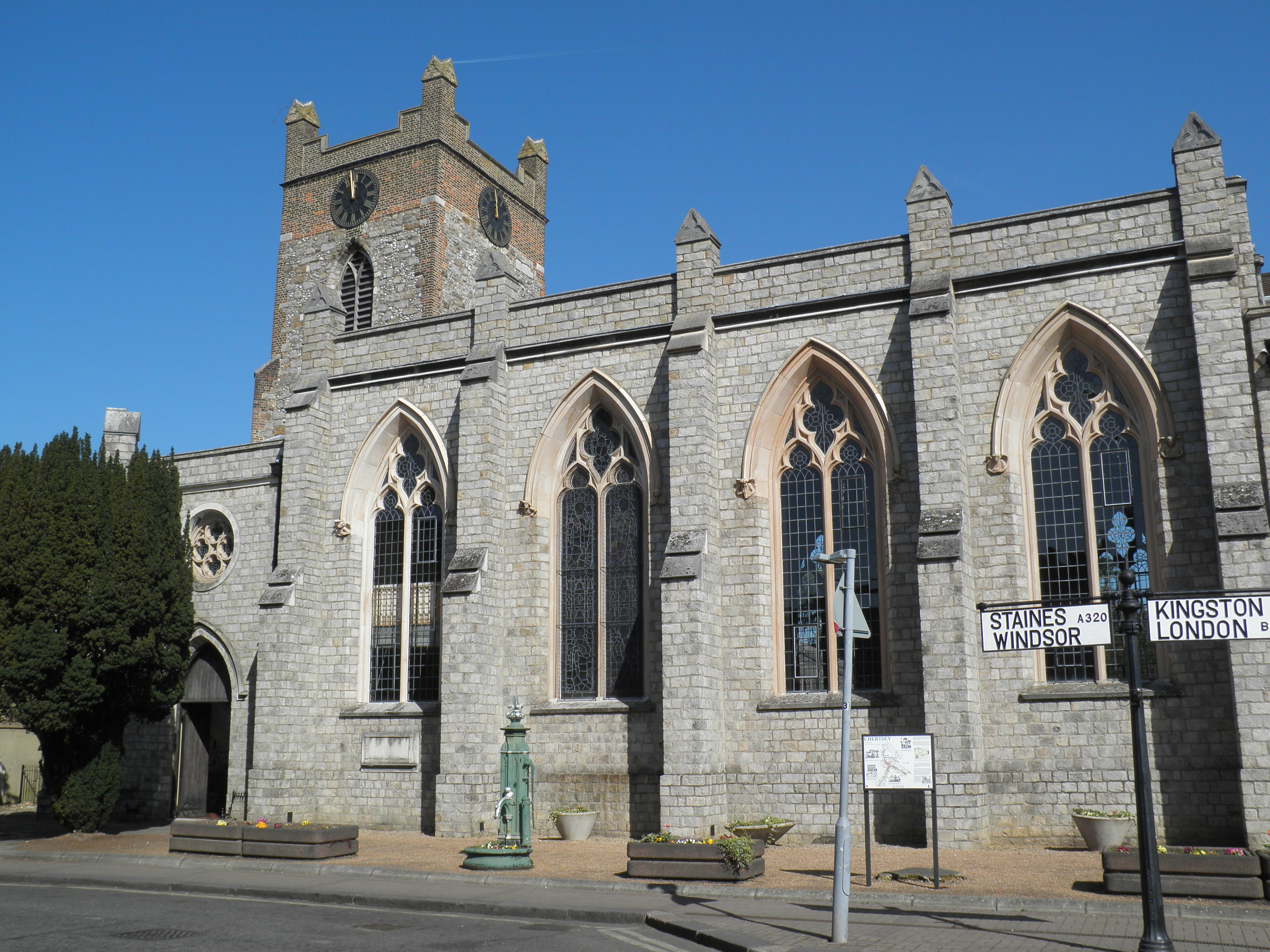
St. Peter's Chertsey. Photograph taken 2012. Author's collection.
- On 8 December 1850, Edward together with his eight month-old brother, Frederick, was christened in the 14th century parish church of St. Peter, Chertsey.
- Tragedy struck during the afternoon of 4 October 1853 when 41 year-old Frederick Garlick, the driver of the Chertsey to London omnibus, collapsed without warning and died instantly while waiting with his horse-drawn vehicle in the Churchyard of that iconic landmark, St. Paul’s Cathedral: just nine days after the birth of his daughter, Jessy.
- The Era, 9 October 1853 – SUDDEN DEATH ON THE TOP OF AN OMNIBUS – Mr. W. J. Payne held an inquest on Thursday morning on the body of Frederick Garlick, age forty-one. The deceased was the driver of a Chertsey omnibus, and had driven up the vehicle to St Paul’s Churchyard on Tuesday afternoon. At about 4 o’clock he proceeded to place a small hamper on the omnibus, when he suddenly fell back upon the roof. Some bystanders believing he was in a fit, got up and rendered assistance, but he was perfectly lifeless. The surgeon, who was examined, said the deceased had died of a disease of the heart, and the jury returned a verdict accordingly. The poor man having left a wife and six children, the jury entered into a subscription for them, and a sum of about £7 was the result of their benevolence.
- Sometime later, his grieving widow and six fatherless children moved to William Street, Kennington, an inner suburb of London in the present-day Borough of Lambeth. In April 1861, young Edward – now age 12 and employed by a baker – was living his mother and two younger siblings in nearby 7 St. Ann’s Road, a modest, terraced dwelling which they shared with one other family.
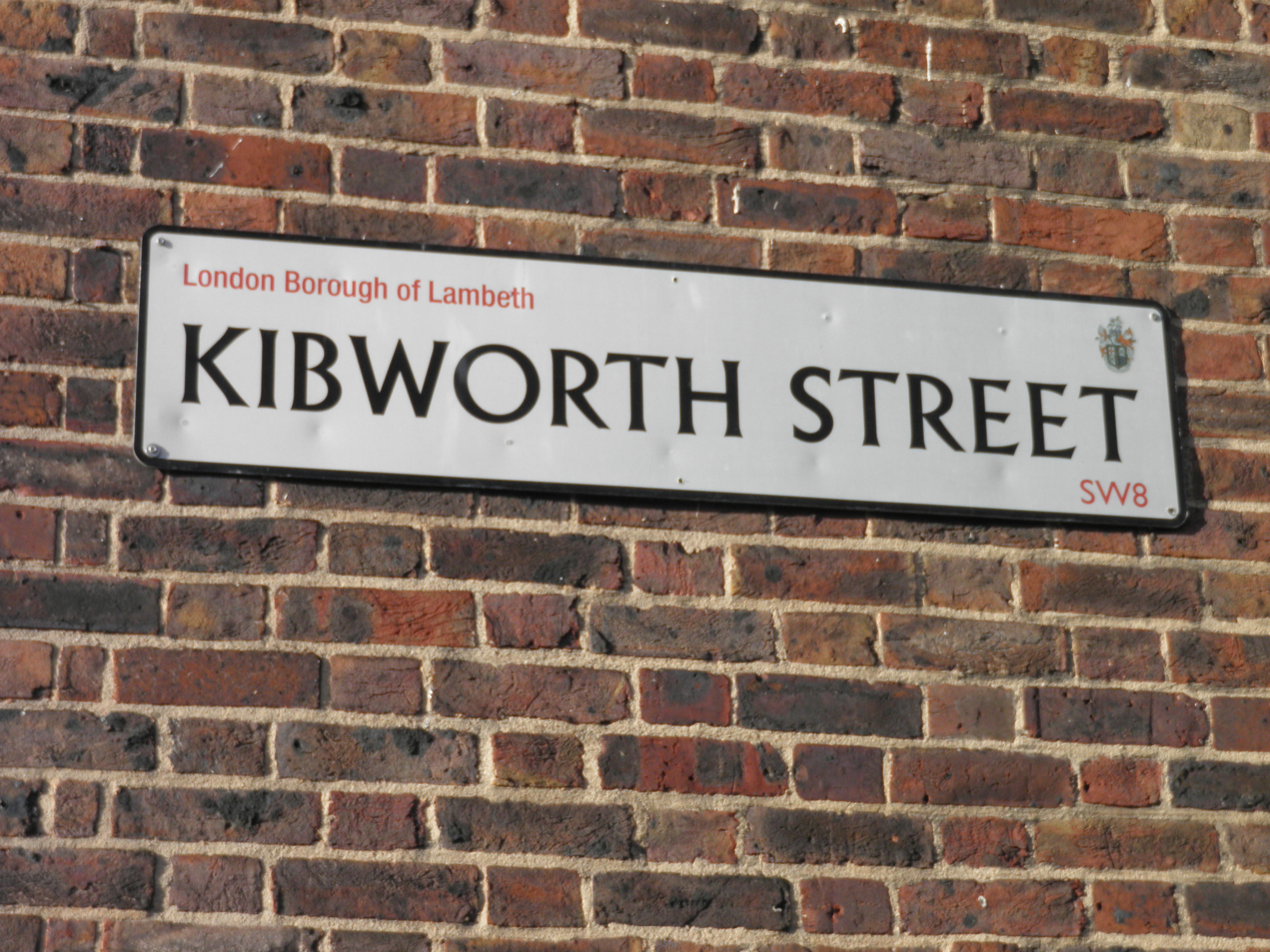
William Street has since been renamed Kibworth Street. Author's photograph [2013].
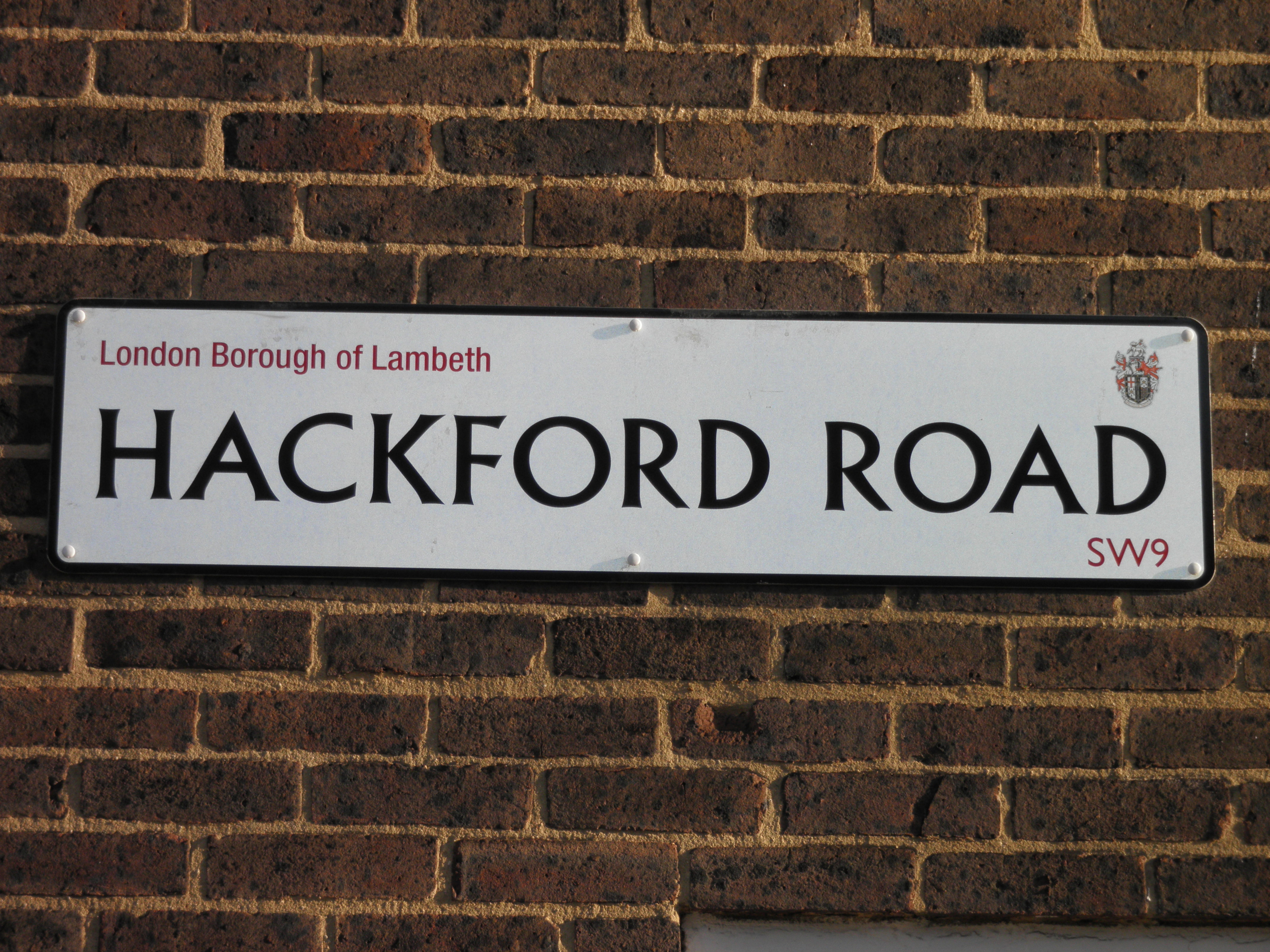
St. Ann's Road has since been renamed Hackford Road. Author's photograph [2013].
- On 1 November 1865 accompanied by his elder brother, John, Edward left Portsmouth for America aboard the sailing ship Liverpool, which docked in New York on December 11. They shared the comparative luxury of a second class cabin, described themselves as “Bricklayers” and each added a year to their true age.
- Nothing further is known about Edward Garlick until 3 February 1866 when he enlisted in the US Army at Richmond, Virginia and was assigned to Company G, 11th Infantry. He was described as having blue eyes, light hair, a fair complexion, standing 6’ 2” tall and previously employed as a “Labourer.” Presumably he looked older than his years as he convinced the recruiting officer he was age 21 in spite of being three months shy of his 18th birthday. The 11th was re-designated as the 20th Infantry on December 6, 1866 and Garlick duly discharged on 3 February 1869, with the rank of a corporal, at Baton Rouge, Louisiana.
- For a second time this lofty Englishman temporarily disappears from the historical record until he presents himself at Jefferson Barracks, St. Louis on 14 April 1871 and his application to re-enlist in the Army is approved by Lt. Peter D. Vroom, 3rd Cavalry. He was assigned to the 7th Cavalry and joined Company G on 30 May, at Taylor Barracks, Louisville, Kentucky when he almost certainly enjoyed the distinction of being the tallest enlisted man in the whole regiment. At this time Company G, under the field command of Lt. Donald McIntosh, was stationed in Spartanburg, South Carolina and engaged on Reconstruction duty. Promotion to corporal came on 16 August 1872 although, for reasons not given, he was reduced to private with effect from 1 January 1873. Over the next few months Company G was relocated, first at Laurens[ville] and then at Newberry, both in South Carolina, before setting out on the long journey to Fort Rice, Dakota Territory, via Memphis, Tennessee and Fort Snelling, Minnesota where it arrived on the tenth of June to prepare for the impending Yellowstone Expedition under the overall command of Col. David S. Stanley, 22nd Infantry.
- Garlick was with his company when on the morning of the 11 August 1873, while encamped near the mouth of the Big Horn River where it flows into the Yellowstone, they and several other companies were attacked by Indians” who after [a] gay engagement of three (3) hours were repulsed. On 23 September the regiment finally marched into Fort Abraham Lincoln, its new headquarters, which is situated on the west bank of the Missouri, on the opposite side of the river to the town of Bismarck, present-day North Dakota.
- In May 1874 Garlick was reinstated as a corporal by the regiment’s commanding officer, Col. Samuel D. Sturgis.
- He also participated in the Black Hills Expedition (1874), often described as “an extended picnic” though one trooper sardonically remarked that “[he had] nothing to do but cut down trees and build roads!”
- On September 29, 1874, Company G left Fort Lincoln for a second spell of Reconstruction duty and arrived in Shreveport, Louisiana eight days later. Again Garlick’s time in the South proved to be generally uneventful.
- Note from Roger Williams – From the troop muster rolls: Garlick was appointed Corpl Augt 11, 72 per Co. order No. 10 to date from Augt 16, 72. (William Summers appointed Saddler per same order to date from July 1, 72). He reduced from Corpl Jan. 1, 73 per S.O. No. 2, HdQrs 7th Cav. Jan. 7, 73.
- He was appointed Corpl May 20, 74 per S.O. No. 92, Hdqrs 7th Cav. May 29, 74.
- 1st Sgt Aug. 6, 75 per C.O. No. 15, Augt 6, 75; (by same order Alexander Brown reverted from 1st Sgt to duty sgt [also noted for Brown…To forfeit $10 of his pay sentence G.C. for Post G.O. 27, Augt 28, 75]).
- Despite his near meteoric rise through the ranks in less than fifteen months Garlick’s character was strangely described as “unexceptional” when his five-year hitch came to an end in Shreveport on 14 April 1876. Be that as it may this did not prevent Lt. McIntosh from approving Garlick’s re-enlistment the same day and in the same rank. Clearly his future plans had been previously discussed with his company commander as his application for “a four-month furlough with permission to go beyond the sea, effective on enlistment,” was granted. Garlick travelled to England to visit his mother and other members of his family whom he had not seen in over ten years and consequently did not participate in the ill-fated Battle of the Little Big Horn.
- The terrible and wholly unforeseen news of the “massacre of General Custer and his troops” at the Little Big Horn (by an overwhelming force of Sioux and Cheyenne Indians), as reported in The Times (London) on 7 July and several countywide newspapers, contained few details of the actual battle beyond the number of men killed, missing in action, and wounded.
- It is not unreasonable to assume that Garlick received the news of his proud regiment’s well-publicised defeat with abject horror and may well have been haunted by pangs of guilt for being absent from his comrades at their time of greatest need. In reality, of course, there was nothing he could do immediately other than (perhaps?) to encourage his younger brother, Frederick, to accompany him back to America to help swell the ranks of a much depleted Seventh Cavalry.
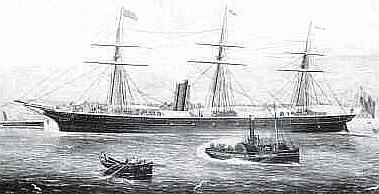
The S.S. Anglia - built 1869.
- Edward and Frederick each duly paid six guineas for steerage accommodation on the Anchor Line’s SS Anglia, which left the River Thames on 5 August 1876 and arrived in New York 14 days later.
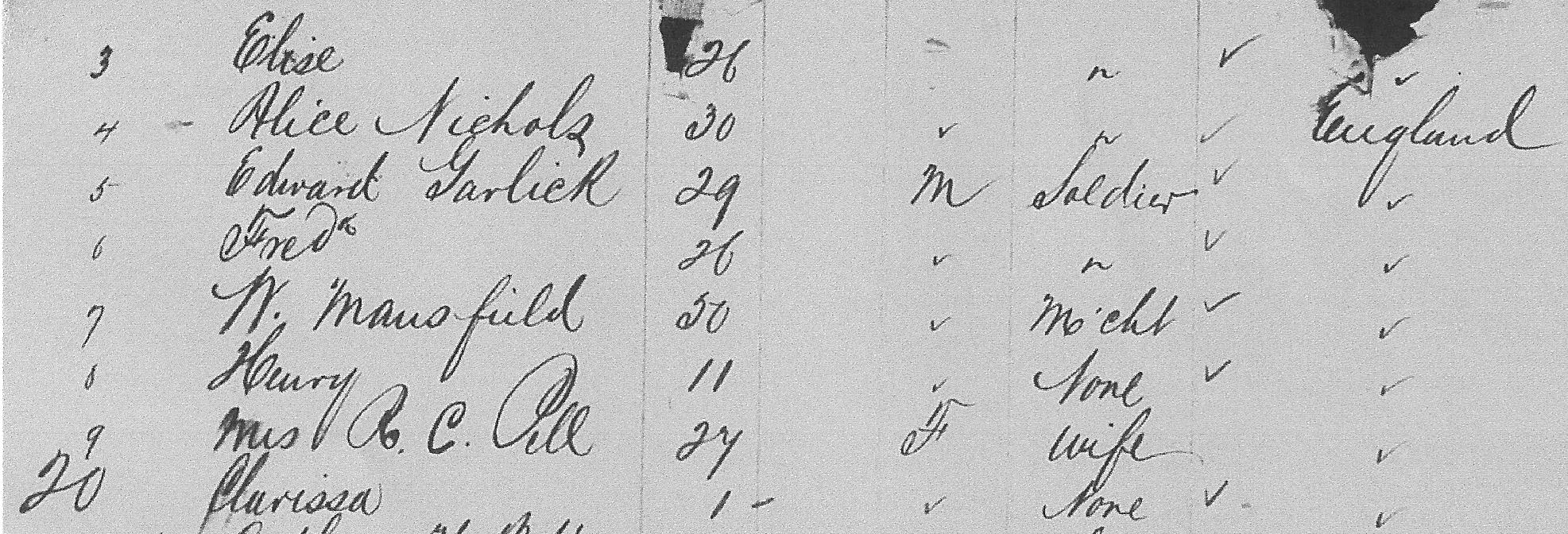
Entry in the manifest of the S.S. Anglia showing passengers 4 & 5, namely Edward and Frederick Garlick.
- Rather prematurely, an enthusiastic Frederick gave his occupation as ‘Soldier’ although he styled himself as ‘Coachman’ on his enlistment into the Army at Fort Abraham Lincoln by 2nd Lt. Alexander Ogle, 17th Infantry, a mere seven days after first setting foot in the United States.
- First Sergeant Edward Garlick reported for duty on 25 August, technically having been absent without leave for 11 days. Only then would he have learned the full extent of the regiment’s defeat and the names of the 14 men of his own company who were killed and the six wounded. He may have been especially moved by the death of Sergeant Edward Botzer, a married man, who was Acting 1st Sergeant of Company G in his absence, and the words “there but by the Grace of God …” must surely have crossed his mind.
- The regiment finally returned to Fort Lincoln on 28 September 1876 and went into camp nearby when Garlick was able to rejoin his company. On the twenty-first of October, Company G formed part of the column under the command of Major Reno that proceeded down the west bank of the Missouri River to Standing Rock for the purpose of “disarming and dismounting the Indians at the Agency.” They returned on November 3 with a collection of mainly broken, obsolete and worthless guns and a large a herd of Indian ponies. Eighteen days later 28 year-old Edward Garlick married 30 year-old Anna Elizabeth Hahn, widow of Trumpeter Henry Dose who was killed at the Little Big Horn.
- On April 30, 1877, following a bitterly cold winter spent in quarters at Fort Lincoln, Company G, now under the command of Lt. Ernest A. Garlington, went into camp near the fort in preparation for field service. The regiment’s distinctly low-key departure the next morning for the Yellowstone country was in stark contrast to that displayed by the flamboyant Custer less than twelve months before although nonetheless it would surely have brought back poignant memories for Anna Elizabeth Hahn, now known as “Annie,” who was carrying Garlick’s unborn child.
- After several months of relative inactivity things warmed up on 13 September when several companies, under Colonel Sturgis, caught up with Chief Joseph and his band of Nez Perce at Canyon Creek, Montana Territory. Garlick, possibly motivated by the desire to avenge the deaths of so many comrades at the Little Big Horn, acquitted himself well that day and was cited by Captain Frederick W. Benteen for conspicuous gallantry in two mounted charges. Company G was relieved from field service on 28 October and from 9 November remained in camp near Fort Buford awaiting the arrival from Tongue River of Cheyenne Little Chief and his band who were to be escorted to Fort Lincoln. However on November 13 Benteen wrote his wife, Kate, handing the letter to Garlick “who was going to Lincoln to see his sick wife, so he said, in giving him a furlough.” Annie Garlick’s condition may have been attributed to the after effects of a difficult pregnancy as their first child, Edward Jess, was not yet three weeks-old. By December 19 Garlick was back with his company and on that day it moved out with its Indian prisoners and arrived at Fort Lincoln on December 30, where it went into winter quarters.
- In February 1879 Mrs Garlick was granted a pension of $4 a month each for Hattie and Charles, children of the late Trumpeter Dose, who had now assumed their step-father’s surname.
- The following spring the regimental Band and Companies C and G were garrisoned at the newly-erected Fort Meade, about two miles northwest of Bear Butte, where the Garlicks second child, Fred William, was born on May 29, 1880.
- Garlick was discharged 14 April 1881 at Fort Meade as “a First Sergeant of Excellent Character” and re-enlisted by his company commander, Lt. Garlington, the same day. For a second time he was granted a furlough, on this occasion for six months, “with permission to cross the sea.” While this writer has not found any record of him crossing the Atlantic it seems almost certain that his mother had died earlier the same year and, if so, he may well have returned to England to settle her affairs. It is also very likely that at least some of this time was spent visiting his wife’s family in Franklin, Lee County, Iowa. Soon after his return to duty in the November he resigned as first sergeant and carried the rank of sergeant for the rest of his army career during which time he served at forts Meade, Leavenworth, Keogh (where he re-enlisted 14 April 1886) and, finally, Riley.
- On May 26, 1887, he was granted a two-month furlough which was spent at Fort Lincoln and St. Louis. It is known that he was suffering from the effects of being exposed to exceptionally cold weather while on duty in the troop’s stables during the previous winter and it is not inconceivable that he used this time to seek specialist medical advice. He was back with his troop by 25 July when the newly-appointed Colonel of the regiment, James W. Forsyth, together with Headquarters, the Band and Troops C, D, G and M, vacated Fort Meade and marched to Fort Riley, Kansas.
- This epic journey took them via the ‘Bar T’ Ranch on Hat Creek, Fall River County about 13 miles from Hot Springs, South Dakota, and Guide Rock, Webster County on the banks of the Republican River in south-central Nebraska. After 736 miles and 45 days in the saddle the column at last reached its destination. Although an average of a little over 16 miles a day might not be considered too onerous for a cavalry regiment it plainly took its toll on an already ailing Garlick and it is not surprising therefore that he was discharged on November 5, 1887, at Fort Riley, on a surgeon’s certificate of disability for “chronic diffuse nephritis accompanied by emaciation & debility, contracted in line of duty.”
- Initially he was awarded a pension of $8 a month, though this was later increased to $18 a month. On 24 February 1888, Garlick was admitted to the US Soldiers’ Home but his name had been dropped from the rolls by 24 April the following year at which time he was residing in Sturgis, South Dakota, a short distance from Fort Meade.
- During the early 1890s Edward and Annie adopted a son, Harry Edward, who together with his wife, Mae Collings, ran Wiggs Confectionery which became something of an institution among teens in Sturgis during the 1940s and ’50s.
- The Federal Censuses of 1900 and 1910 state that Annie Garlick had given birth to six children of which two were deceased. It is known that eight year-old Heinrich “Harry” Vetter or Dose died of scarlet fever at Fort Lincoln in May 1876but the identity of the second child – assuming the information given was correct – is yet another mystery waiting to be solved.
- Over time Garlick’s health evidently recovered sufficiently to enable him to work on a hack line, then a dray line and transfer, and, finally, for many years as a carrier of the US Mail between Sturgis and Fort Meade.
- His pension was increased to $50 a month on June 17, 1927 (for 75 years of age) under the Act of 3 March 1927.
- Eighty-one year-old, Anna Elizabeth Hahn Garlick, formerly Dose, affectionately known as “Grandma Garlick” and held in the highest esteem by friends and neighbors, died in Sturgis on 15 February 1928, after a long illness. Two days later, following a well-attended service at the Grace Lutheran Church, the former German-born Seventh Cavalry laundress was laid to rest in Bear Butte Cemetery, which is located at the far east end of Sherman Street.
- An increasingly frail Edward Garlick was cared for by Edward, his elder son, and daughter-in-law, Elizabeth Schnell, at whose home he passed away on Sunday morning, 25 January 1931, as a result of Bright’s Disease. An equally well-attended funeral service was held the following Friday afternoon at St. Thomas Episcopal Church, after which the cortege travelled the short distance to Bear Butte Cemetery. A military honor guard fired the traditional three volleys and a trumpeter sounded “Taps” before the old cavalryman was reunited in death with his beloved Annie. Impressive pink granite headstones, adorned with the words ‘Father’ and ‘Mother,’ mark the graves.
- Notwithstanding being discharged from the Army on the grounds of serious ill-health while still only in his late thirties Edward Garlick lived to the ripe old age of 82, which was not surpassed by any other member of Company G, 7th Cavalry, who served in June 1876.
- Postscript: Edward Jess and Elizabeth Schnell Garlick had one child, Jess Edward (1903-64), who married Ida Ellen “Idell” Quinn (1907-90) in 1939. Jess and Ida were also blessed with a son, Edward W., born 1945 in Sturgis, who at the time of writing resided in Reno, Nevada..
![garlick [1]](https://www.menwithcuster.com/wp-content/uploads/2013/03/garlick-1.jpg)
Edward Garlick. Date unknown. Courtesy of Fort Meade Museum Museum
![garlick [2]](https://www.menwithcuster.com/wp-content/uploads/2013/03/garlick-2.jpg)
Edward Garlick. Date unknown. Courtesy of Fort Meade Museum, Sturgis South Dakota.
![garlick [3]](https://www.menwithcuster.com/wp-content/uploads/2013/03/garlick-3.jpg)
Anna Elizabeth Garlick (formerly Dose, nee Hahn) and Edward Garlick in old age. Date unknown. Courtesy of Fort Meade Museum.
![Garlick [5]](https://www.menwithcuster.com/wp-content/uploads/2013/04/Garlick-5.jpg)
Edward Garlick Headstone (note incorrect date of birth), Bear Butte Cemetery, Sturgis, South Dakota. Courtesy Scott Nelson.






![garlick [1]](https://www.menwithcuster.com/wp-content/uploads/2013/03/garlick-1.jpg)
![garlick [2]](https://www.menwithcuster.com/wp-content/uploads/2013/03/garlick-2.jpg)
![garlick [3]](https://www.menwithcuster.com/wp-content/uploads/2013/03/garlick-3.jpg)
![Garlick [5]](https://www.menwithcuster.com/wp-content/uploads/2013/04/Garlick-5.jpg)
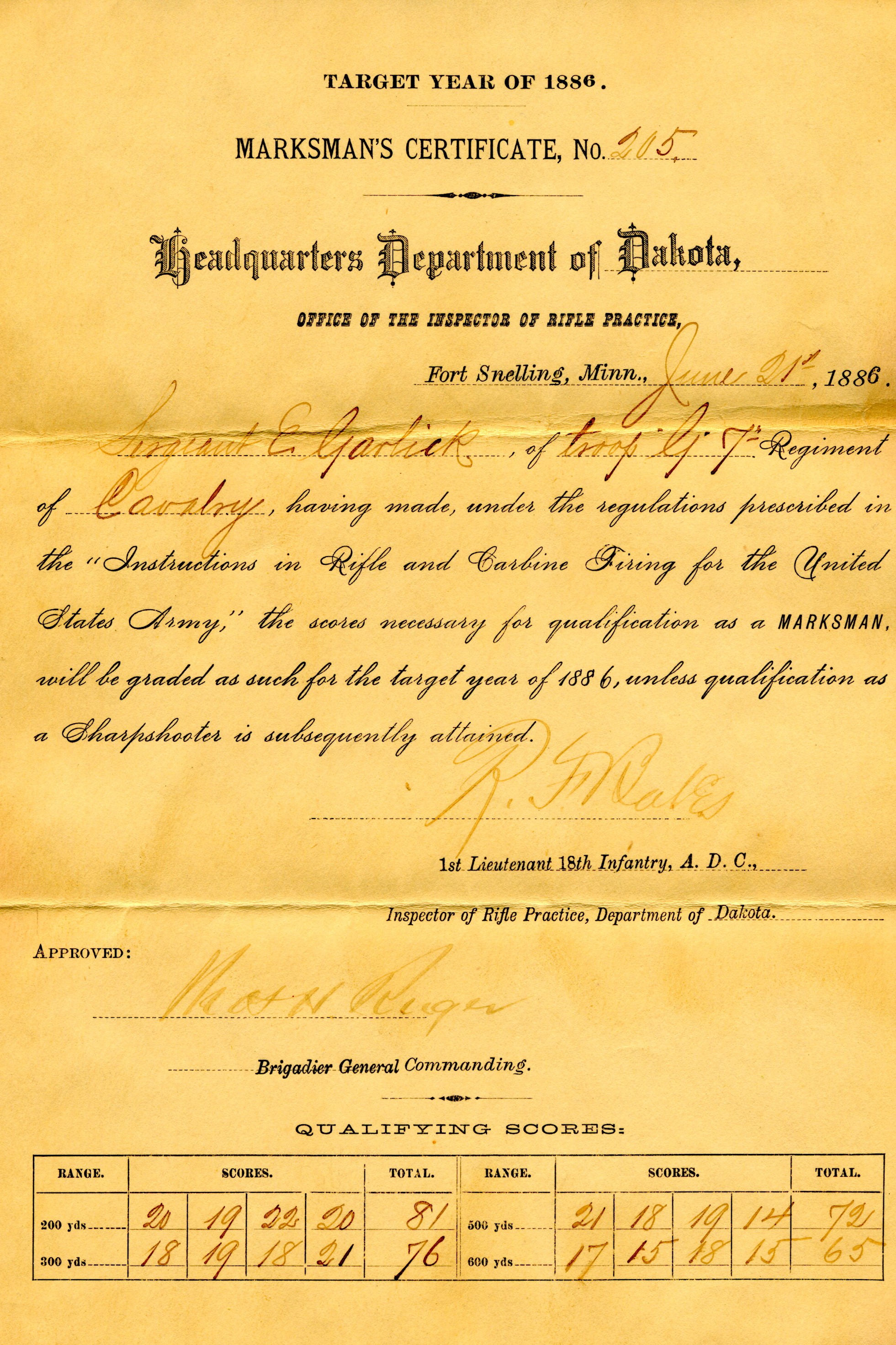

















Comments:
Edward Garlick was born 8 May 1848, not 8 May 1846 as is generally stated.